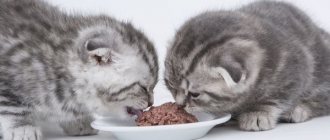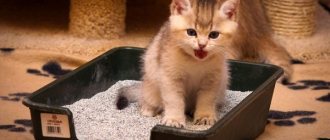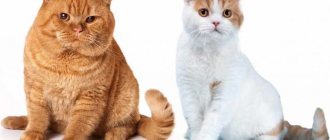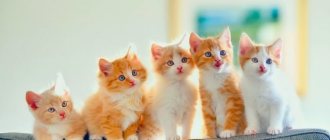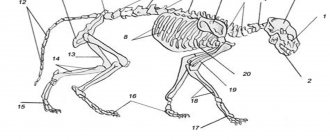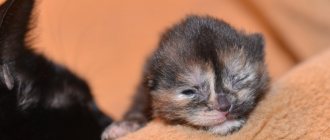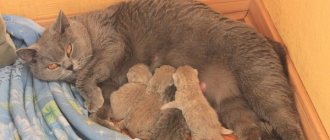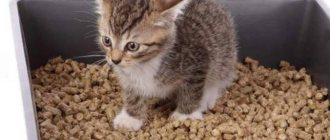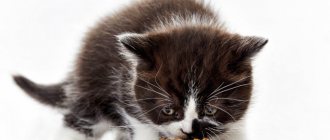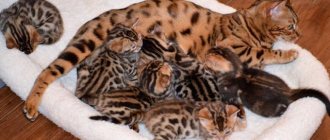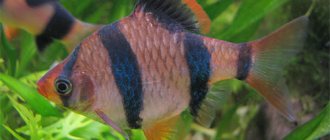A Scottish Fold kitten with a rounded muzzle, large eyes and charming, inconspicuous ears evokes delight and affection even among those who are indifferent to pets. Every day the number of owners of such cats is increasing. The breed is becoming increasingly popular. However, breeding Scottish Folds is not as easy as it seems at first glance. Initially, every kitten of this breed has straight ears. When the process of their descent begins, do all kittens develop lop ears - the most common questions that occupy new owners of such a pet.
7-12 months
Stages of further development of Scottish:
7 months. It's time for puberty
When the first shedding occurs, it is important to comb the fur on time and make sure that the animal does not swallow its own hairs. They offer him cat grass and a special hair removal paste. 8 months
Castration and sterilization are carried out. 9 months. Scottish already resembles an adult cat, but he can still continue to be given baby food. 10 months. Animals actively demand “love acquaintances.” However, mating at such an early age is undesirable - the cat’s body has not yet formed for procreation. 11 months. The animal is gradually transferred to adult food. The frequency of lunches is reduced to 3 times a day.
One-year-old “Scots” are no longer growing. However, they continue to develop: gain mass, increase in width, build muscle. This process is completed by 2-2.5 years.
Scottish cats at 9 months:
Photos, videos of Scottish cats at 1 year:
General information about fold-eared breeds
The history of the breed began in 1961, when an unusual white cat, Susie, was discovered on a farm in Scotland. The tips of her ears were bent forward and covered the upper part of the ear canal.
Susie later gave birth to kittens, two of which (a boy and a girl) inherited a genetic ear abnormality from their mother. The cat was castrated, so he did not leave offspring. And a cat named Sans was purchased by William Ross, who lived next door.
Ross brought geneticist Pat Turner into the matter and the two of them began breeding a new breed. Local British cats were used as partners for Sans, and as a result, 76 kittens were born. Of these, 42 were born with fold ears, and 34 with ordinary ears. This was enough to write an application for the creation of a new species. But life made its own adjustments.
In 1971, the registration of fold-eared cats was canceled. The animals exhibited diseases of the bones, spine, deformities of the limbs, deafness, a tendency to infectious diseases, and much more. It is possible that the story of the Scots could have ended there, but the situation was saved by geneticists from the USA. The problem was solved quite simply. All diseases turned out to be a legacy of the connection between homozygous cats (having the same alleles for lop-earedness). As soon as they began to be bred with straight-eared Scots (heterozygous), healthy kittens were born.
In 1978 the CFA gave the Scots show status. It took another 15 years to establish the standard of the new breed, which was called the Highland Fold (the first cats were long-haired). Later, shorthaired fold and straight-eared Scottish cats were recognized. They became Scottish and Highland Straights.
Determining gender in other ways
There are several other methods for determining whether a kitten belongs to one gender or another. Below we will look at which are reliable and to what extent.
By color
A very reliable method if we are talking about a tortoiseshell kitten: black, blue-cream or patchwork (tri-color) “tortoise”. A tortoiseshell kitten is 99% of the time a cat. This is explained by the fact that all colors without exception are formed by two genes - “black” and “red” (red). Blue and cream colors are “lightened” blacks and reds.
The color gene is always transmitted by the female X chromosome, so there can be no discrepancies in cats: XY - one color, black or red, transmitted by the mother. Cats have two chromosomes carrying color genes: XX - therefore, it is possible to transmit either red or black genes, or both at the same time, which gives the tortoiseshell color.
Tortoiseshell boys are born very rarely, and their color is a genetic deviation (extra X chromosome: XXY - giving the wrong second color gene). Therefore, “tri-colored” cats are born sterile. All other colors are normal for both sexes.
By voice
With a certain stretch, one can consider the method effective: it is believed that cats have more low overtones in their voices, and cats have more high ones. In fact, quite a few cats have a rather gentle contralto voice, and the voices of some cats, on the contrary, sound menacing and not at all feminine.
In the face
It is believed that the outlines of the girl’s face are more subtle and soft, while the “portrait” of the cat is sculpted roughly, with wider cheekbones and the back of the nose. In reality, the method, of course, cannot be considered reliable. “Facial features,” like in humans, are inherited from parents. Which makes it more than likely both the subtle aristocratic features of the cat’s appearance and the harsh features of some four-legged young ladies.
Moreover, there are breeds of cats (a striking example is the Maine Coon), whose breed phenotype obliges them to look like wild, angry predators, regardless of gender. There are also breeds of graceful, fine-boned cats, the characteristics of which are reflected in the features of the males enough to confuse the untrained eye.
By weight
Weight is a criterion by which it is theoretically possible to determine the sex of an animal, but the reliability of the method is very low. It can be considered more or less reliable in two cases:
- If daily control weighings of the litter show a consistently high weight gain of some kittens compared to others (indicators vary for different breeds and individual body characteristics of animals).
- If size and weight are breed-forming characteristics and significantly exceed the values possible for cats, with a high degree of probability the luxurious dimensions belong to the representative of the stronger half. The disadvantage of this method is that by the time they reach the indicative size and weight, the animals have already grown enough to easily determine gender based on anatomical characteristics.
Veterinary method
You can accurately find out the gender of a kitten by contacting a veterinary clinic. If a visual examination by an experienced veterinarian does not allow accurate results (for example, when the length and thickness of a very small kitten’s fur “confuses the indications”), there is always the opportunity to donate blood for a test. It makes sense to resort to this method when it is the only way, and for some reason the result needs to be known urgently.
Straightening - pros and cons
Despite the fact that this breed of cat attracts many breeders and ordinary fanciers, their peculiarity does not always have a positive effect.
Fold-eared cats are more likely to suffer from various ear diseases, even before they are raised. Parasites spread quickly and remain unnoticed until the last stage, because the structure of the auricle is conducive to the formation and accumulation of wax. These areas should be inspected and cleaned regularly by lifting the ears.
Often, the elevated state disappoints the owners, because at an early age the animal may still have fold ears. Many people, in pursuit of the ideal breed, begin to cross incompatible species, after which sick kittens are born with many pathological abnormalities. Don’t despair if the kitten’s ears straighten; in some cases, they may “fall” again.
Fold cats themselves are friendly and quickly become attached to their owner. Because of this “zest”, cat care is carried out more carefully and tolerantly
Sometimes problems arise from physiological characteristics, so it is important to regularly carry out preventive measures. When raised, sulfur and other dirt do not accumulate in them, and any symptoms can be immediately noticed
Changes related to the position and structure of the ear canal occur 5 weeks after birth. They can be temporary, that is, if the ears rise in hot weather, it is more likely that after some period they will fall again.
It also happens that irreversible straightening occurs. More often after the first birth or first mating. There is no need to forcefully try to return your former lop ears. This can happen to any kitten in the litter, even if he has a good pedigree. It is rare to find cats whose position does not change throughout their lives, and therefore such breeds are raised for presentation at exhibitions and other similar events.
Straightening occurs for various reasons; before getting a cat of this breed, you should consider the characteristic features so as not to be disappointed in the choice later. Fold-eared cats require special care, even if the structure of the ears has changed. When buying a purebred cat, you need to study its pedigree - this will help you avoid scammers who offer ordinary animals at high prices.
Related publications:
What could cause a swelling of the lower lip in...
Why did the cat start eating a lot?
The cat's color has changed: what is the reason?
What causes intestinal inflammation in cats: first steps...
On the eve of childbirth
Usually a woman in labor copes with childbirth on her own, but a responsible owner should keep ready everything that may be useful during childbirth: clean towels, disposable diapers and gauze napkins, scissors and thick threads in case you have to cut the umbilical cord yourself, boiled water and a first aid kit, the contents of which should be discussed with your veterinarian in advance.
If your pet is constantly being observed by the same doctor, ask him for a phone number before giving birth in case of unforeseen circumstances or find contacts of a veterinary hospital where 24-hour consultation is available. Also make sure that you can go to the nearest veterinary clinic at any time, which is always open and you know the way to it and its exact address, in case you have to get there by taxi or on your own.
Childbirth is a moment of crisis for any cat and requires control from the owner
If a cat gives birth safely at home, she will eat the afterbirth after the kittens - this is absolutely normal. Some experts believe that it is enough to give the cat the afterbirth of only one kitten - especially if she has problems with the gastrointestinal tract. By the way, if the labor is long, then it is allowed to feed and water the woman in labor - this will give her strength. After giving birth, you need to clean the nest and leave the cat alone - she will have to carefully lick and feed each kitten.
How to understand that a cat is bothered by a sore ear, symptoms
When a pet feels unwell, something hurts, the owner tries in every possible way to help the cat. First, you need to carefully monitor the cat’s behavior so that a more accurate diagnosis can be made. Here are some of the symptoms that indicate ear problems:
- the first sign of illness is the cat’s refusal to eat;
- head jerking. The cat seems to be trying to get rid of a foreign object that has gotten into its ears. He often shakes his head, shakes it, and often scratches his ears with his paw. Many animals try to keep their heads slightly tilted. All this suggests that the cat has ear pain;
- with some diseases, the skin on the inside of the cat’s ear becomes slightly red and may swell;
- black plaque and even scabs may appear in the cat’s ears;
- if external manifestations are invisible, then you need to press on the cat’s ear, which hurts. If you hear a sort of “smacking” sound, and liquid with an unpleasant odor is released from the ear, then the cat has problems with the ears;
- The cat's temperature rises.
shutterstock
These are all symptoms of ear pain. For some diagnoses, you need to see a doctor, and some problems can be solved yourself. But in both cases, it is necessary to first get advice from a specialist in order to make sure that the problem is identified correctly.
Rules for determining lop ears
You can determine whether a kitten is a fold-eared cat or not, not only by the appearance of the little Scotsman, but also by using some additional methods:
- Meet the parents of newborn Scottish Fold kittens. The father, as a rule, does not live with the offspring, but the cat is always with the babies for up to 2.5 months. She may belong to the Straight group, but if all the other breed characteristics are recognizable, then the litter must have fold-eared kittens.
- In order not to accidentally confuse a mestizo with a purebred animal, you need to inquire about the availability of documents. Even when the father is not around the kittens, breeders keep a photocopy of papers confirming his breed. If you have elite parents, you can understand that the fold-eared kitten in the litter will definitely not be a half-breed.
- If there is no confirmation of the breed of one of the parents, you should familiarize yourself with the mating documents. Felinological clubs always draw up an act according to the established template and register it. This will help you know that the fold-eared kitten was born legally.
- By the time the kitten is sold, the breeder must prepare metrics.
- If a small cat's ears stand up immediately after birth, this is normal. Folding is determined later. Therefore, you cannot take a kitten from the nursery before it turns 3 months old.
- In the early stages, even experienced experts cannot understand whether the kitten will be a fold or remain a straight. An ordinary cat, especially a mixed-breed cat with a high proportion of Scottish blood, may look like a purebred cat in the first weeks. But the difference will definitely appear by 3 months of age.
The choice of nursery or breeder is of great importance. Perhaps reputation can become a determining factor here. Owners know the capabilities of their pets better than others and predict in advance how many straight- and fold-eared babies a particular cat will have in the litter. They can give the most valuable advice on maintenance and always try to select only responsible and conscientious owners for the kids. Therefore, the final recommendation on how to avoid becoming a victim of scammers applies specifically to the behavior of breeders. They never give away very small kittens, they are always interested in the expected living conditions of their pets, willingly share advice, and show photographs of parent cats and children from previous litters. In this case, the buyer can be sure that he is purchasing a purebred Scottish Fold.
Loss of characteristic: when the ears rise
Straight-eared kittens are called straights, and fold-eared kittens are called folds. The clear difference between them lies in the presence and number of folds on the ears. One fold causes the ears to straighten over time. This does not mean that the kitten is straight. To answer the question about his breed, an examination is carried out. It is especially important for owners who plan to crossbreed kittens. An incorrect conclusion about the straightness of an animal leads to the crossing of two lop-eared individuals and sick offspring. If there are two folds, then it is impossible to predict the outcome: the kitten can remain fold-eared with the same success as become straight-eared. Three folds ensure the ears don't straighten out.
External differences between British and Scottish cats
Folds with erect ears are sterilized to prevent the transmission of a dominant gene that has lost visual expression.
There is a clear sign that distinguishes a fold-eared cat with erect ears from a straight-eared one: the size of the ears. The first one has smaller ones.
Temporary changes in the position of the ears are also possible, the cause of which is weather conditions. The heat causes the Fold's ears to rise slightly.
Important! To purchase fold-eared kittens, choose a time of year with moderate temperatures.
In addition, the ears of the folds also rise in females after giving birth.
Video - Scottish Fold cat
Rules for feeding three-week-old kittens without a mother
Three-week-old kittens are very vulnerable, although if you compare their size and potential ability to survive, you have a very good chance of being bottle-fed
It is important to understand that even if you do everything correctly, there is a risk of the kitten dying even at 3 weeks of age
Recently, veterinarians have not recommended resorting to homemade recipes for making milk substitutes, but trying to feed kittens only with ready-made formulas. This theory may be correct, but cat milk substitutes are rarely sold in small towns and villages. Below are recommended milk substitutes and recipes for preparing the mixture at home.
The general rules for feeding three-week-old kittens without a mother are that the guardian must perform all the manipulations that are assigned to the cat:
- Heating.
- Maintaining cleanliness.
- Taking care of your health.
- Feeding.
Until the kittens’ thermoregulation stabilizes, and this will happen at the age of 1 year 1.5 months, the temperature in the nest must be maintained at 25–28 degrees. The nest should be clean, safe, and located away from drafts and heating radiators.
For massage, use a clean cotton sponge soaked in warm water. The general idea is that you should imitate a cat licking itself. Without these manipulations, the kitten will not be able to go to the toilet and will die within 24 hours.
Wipe the kitten's face thoroughly after feeding and make sure that its fur does not stick together. The condition of the coat is one of the main indicators of health, which you will focus on when feeding a kitten artificially.
Naturally, the main aspect that ensures the survival of a three-week-old kitten that cannot eat on its own is timely, high-quality, balanced feeding. Let's take a closer look.
What you need to feed three-week-old kittens
First, let's figure out what is needed to provide the kitten with the most comfortable living and feeding conditions. Perhaps you already have something from this list; if not, you need to purchase what you need as soon as possible:
- A heating pad, preferably an electric one, with a regulator.
- Large supply of cotton and terry cuts.
- Gauze cuts and swabs.
- Cotton sponges.
- The gloves are disposable.
- Kitchen scales are the only way to track the development of a kitten, this is regular weighing.
- Moisture-wicking diapers.
- Feeding bottle - you can buy or make it. If you don’t have a bottle, you can use a syringe or pipette at first.
- A drug for children against colic, for example, Espumisan.
- A small box is a nest.
- Thick fabric that allows air to pass through well - cover the box so that the kittens are in the dark and do not worry.
- A soft toy with short hair - many kittens get very worried if their big and fluffy “mother” is not nearby.
If a three-week-old kitten is walking and has begun to open its eyes, you will need a bowl with low sides. A saucer can be used as a temporary alternative. As soon as the kitten begins to react to smells, silhouettes and shadows, you need to try to teach him to eat on his own.
Feeding methods
As mentioned above, there are different feeding methods. The kitten can be fed from a bottle, syringe or pipette. When feeding from a syringe, there is a risk of the piston slipping, as a result of which milk can enter the kitten’s respiratory tract. When feeding from a pipette, the kitten cannot suck, so the milk mixture stains the fur.
Three-week-old kittens hold their heads well, so during feeding you need to make sure that the baby is lying on his stomach. Especially for feeding, you can use a small plastic box so that while eating, the baby can rest his back paws on its side. If the first few times the kitten doesn’t eat well, a lot of formula spills and something doesn’t work out, don’t panic. It takes time for your baby to adapt to eating in an unnatural way.
Feeding mode
Most veterinarians recommend feeding kittens up to one month of age on demand. Try to develop a consistent feeding schedule based on the speed of food digestion depending on the age of the kitten.
The standard feeding regimen looks like this:
- From 14 to 18 days, kittens eat 9 times a day without a break for night sleep.
- From 18 days to 1 month, kittens eat 8 times a day without a break for night sleep.
What to feed a kitten
If the new owner does not have time to prepare a full menu for the kitten from fresh and high-quality natural products, then the best choice is to accustom the “Scot” to premium dry and liquid food. This is a balanced and high-quality food that contains everything necessary for a representative of the breed. The breeder or veterinarian will help you decide on the brand and type of product - in many nurseries the animals are fed ready-made food.
Natural nutrition requires more time, money and effort. It cannot sometimes be replaced with ready-made food, so as not to cause persistent gastrointestinal problems in the kitten. If the baby was offered food from the breeder, the transition to natural nutrition goes very smoothly. The owner must monitor how the pet’s body reacts to a new dish.
The main rules for fans of natural feeding:
- Under no circumstances should you offer your pets raw fish due to the risk of helminths and infections. You should completely discard river water, and be sure to boil sea water, remove the bones and give it only in small portions - it can cause urolithiasis.
- Chicken and beef meat is cleaned of bones and cartilage, finely chopped or minced, boiled or doused with boiling water.
- Meat and fish are served with a “side dish” of porridge – buckwheat, oatmeal, rice. The “dish” is not salted or sweetened.
- The offal must be thoroughly washed and boiled.
- Fermented milk products - only with a small percentage of fat content, always fresh.
A Scot should have free access to filtered, boiled water at room temperature. A sufficient frequency of feedings is 4-5 times a day.
Duration of pregnancy
A cat's pregnancy lasts on average about 9 weeks. A more accurate period depends on many factors such as age, weight and breed characteristics. For example, owners have found that the process of bearing offspring in short-haired females lasts 58-68 days, in cats with long and medium-length hair it lasts 63-72 days.
How many kittens can a cat give birth to?
The length of pregnancy is also affected by the number of babies inside the womb. The more there are, the earlier the due date will come. Females bearing one to two kittens are able to walk for as long as possible before giving birth. In addition, their health depends on the number of cubs. Statistics show that babies from multiple litters are weaker and sicker.
For your information! In one litter, a female can bring from 2 to 8 kittens, the exact number of which depends on many factors.
Puberty in cats
In a Scottish pet that comes into the family at the age of 3 months, sexual maturation can begin early, at 4.5 months. Physiologically, a Scots kitten will gain strength only after 9 months or later. The reproductive period, the gestation period comes after 10 months, lasts on average until 7-8 years of age. Premature pregnancy is harmful to the kitten’s fragile body.
The cat is in heat
Scots are a breed with average sexuality, so during the period of heat, many do not arrange unbearable concerts. The period of the first and all subsequent heats is difficult not to notice; within 3-4 days, the imperturbable Scottish woman’s behavior changes dramatically. She becomes either too affectionate or restless, runs after family members, and constantly makes sharp “meowing” sounds. Begins to mark the surrounding space around. These cat days are called estrus, rut, or hunting.
According to the nature of its passage, estrus can be divided into periods:
- The first one goes quite calmly. The cat develops small transparent discharge from its intimate parts, signaling the onset of estrus;
- In the second period, the character changes dramatically, the cat constantly screams heartbreakingly, emitting different sounds, calling out the cats. She may not eat, constantly raising and lowering her tail, periodically rolling on the floor or raising her butt.
- After a few days, she calms down and gradually returns to normal.
What should a cat normally do?
If everything is fine with the animal after giving birth, it will definitely take care of the offspring that are born: the cat’s task is to remove the remnants of the placenta from the kittens, lick them and push them in the direction of the nipples.
First, your pet carefully licks her babies, first of all freeing their eyes and nose from the mucus that got there during the birth process. After this, the animal takes the umbilical cord into its mouth and, chewing it (at the same time, the umbilical cord is effectively crushed), chews it. In addition, “experienced” women in labor carefully lick the umbilical area: the saliva that gets into the wound, rich in antibacterial substances, prevents the development of inflammation.
Finally, the cat carefully and diligently licks the anal area of each kitten individually. She does this for the effective removal of original feces. If the babies are not very “smart,” your pet will definitely push them towards the nipples. It is interesting that breeders have long made a simple and logical conclusion: kittens that “without prodding” accurately determine the direction of the “milk fountains” are 100% likely to grow up to be the largest and physically strongest.
Note that cats constantly nurse their babies for about an hour or two from the moment the latter is born. Since their eyes begin to open somewhere towards the end of the first week, the mother deliberately lies sideways to her babies so that they can always find nipples with milk. If your pet exhibits restless behavior and cannot calm down, forcefully put it down.
- After about two weeks, the cat no longer “indulges” the cubs so much, and only lies down to feed when they all start poking at her stomach at once.
- Starting from the age of four or five weeks, when the offspring have long and sharp teeth, the mother increasingly refuses to feed them and runs away, sometimes hissing indignantly.
- By eight weeks, kittens can be completely weaned and finally transferred to “adult” food.
Be sure to watch whether the cat licks the genital area of newborn kittens: for about three days, the instincts that promote natural bowel and bladder emptying do not work in babies, and therefore the mother must induce these processes artificially.
And she also has the unpleasant responsibility of eating all the excreted feces and urine (natural expediency - so that there is no smell of anything around the den). However, in practice such care often lasts much longer than three days, and the cat stops licking the “private” areas of her kittens only after the babies themselves can crawl outside the place of their birth.
The first months of life of Scottish Fold kittens
In the first weeks of life, kittens go through stages from helplessness and huddling around their mother to independent activity and exploration of their environment.
On day 10, their eyes open: they feel more confident and begin to crawl around the cat. After a month, the kittens are fed food that will be their diet throughout their lives. At the same time, they leave the boxes that served them as shelter during the helpless period of life and master the surfaces. This is a favorable period for training a kitten to use a litter tray.
Color genetics
Kittens' eye color gradually changes: from dull blue to their real color. This process takes up to 2 years and is called reblooming. The inclusions appear first, which then spread and provide a permanent color. Green eyes take the longest to form.
How to come to terms with loss
But sometimes kittens die, despite competent and timely help. There is no universal way to help ease the pain of loss. But those who have encountered such grief are advised to adhere to certain rules.
First, you should understand that it is normal to experience grief. Therefore, a person must give himself permission to suffer for a certain amount of time. It is advisable not to keep emotions to yourself, but to cry or shout them out in some deserted place (in the forest, in a closed car, or in a house when there is no one in it). Exercising or performing monotonous activities can also help distract you.
Secondly, it is necessary to get rid of the feeling of guilt for the death of the kitten. Paradoxically, the more effort a person makes to save his pet, the more he reproaches himself subsequently. You need to understand that the law of natural selection exists in nature and it is pointless to argue with it.
Thirdly, you should get a new furry pet. Some people, having experienced the loss of one kitten, do not dare to have another baby for fear of going through the pain again. But, as practice shows, the happiness that a new “family member” brings overcomes the bitterness of loss. In addition, new worries take up all my free time.
Also, after the kitten has died, the owner needs to decide what to do with the deceased animal. Most cities have laws that prohibit burying pets in flowerbeds and parks within the city. Therefore, it is best to take the kitten’s corpse outside the populated area and bury it in a picturesque place.
In large cities there are crematoriums and cemeteries for pets. This is an expensive procedure, but many wealthy people prefer to use such institutions.
They say that a dead animal runs to heaven on a rainbow. There is no need to darken his path with bitter tears. It is better to remember the happy moments spent together.
How to choose the right one?
There are some recommendations and rules for choosing purebred Scots:
- The animal must be healthy with dense hair, clean eyes and a soft belly to the touch.
- Real folds look cheerful, playful and content.
- It is necessary to have a pedigree and a passport of the animal, especially for its participation in exhibitions and competitions.
- It is necessary to find out from the breeder who the kitten’s parents are, since their genetics affects the health of the babies.
- A real fold-eared cat will have a high cost. If a seller sells a pet cheaply, then you need to think about whether it is defective.
By following these rules, you can easily choose a pet with good health. If you want to make an affectionate, gentle, playful friend, following all the recommendations, this breed is better suited. In order to quickly and easily make friends with your pet, you need to carefully watch the reaction and behavior. It is possible to determine a suitable cat this way: if it does not attack a person, does not snort, and does not try to run away. If a lop-eared pet purrs, then this is a sure sign of the beginning of friendship between him and the future owner.
The second stage is independence and growing up
| Age | Image | Peculiarities | Recommendations |
| Sixth week | The final transition from mother's milk to foreign food | Feed the kitten 6 times a day, 40 grams of food at each meal. Observe the animal's stool; if there are any problems, contact a veterinarian after 3 days. | |
| Seventh week | Weight – 550-900 g. Males stand out among females in size | The kitten should not drink its mother's milk. Balance of dry and liquid food | |
| Eighth week | Weight – 750 – 1200 g. All milk teeth. Eats solid food | Separate from mother. Get examined by a veterinarian. Monitor the condition of your ears and eyes. Comb | |
| Ninth week | Forming a type of relationship with the owners | Get vaccinated | |
| Tenth week | Weight – 850-1400 g. Independence. Sensitivity to learning | Do not be aggressive in training | |
| Eleventh week | Research stage: exploring the corners of the apartment | Prevent the kitten from colliding with dangerous objects: close windows, remove small parts, toxic substances | |
| Twelfth week | Weight – 900-1600 g. Change of eyes Pet’s response to its name, to the call for food | Organize repeated prophylaxis against worms. Stop kitten aggression | |
| Thirteenth - fifteenth weeks | Weight – 1.5 kg. Molars appear | Feed 5 times a day. Trim nails regularly | |
| Sixteenth week | Weight – 1.8 kg | Get vaccinated | |
| Five months | Weight – 2 kg | Feed 4 times a day. Get a rabies vaccination | |
| Six months | Strong molars. Dimensions of an adult animal. Puberty | Organize worm prevention. Feed 3 times a day. Sterilize if there is no goal to breed offspring | |
| Seven months | Seasonal molt | Brushing your pet | |
| Eight – nine months | The cat is almost an adult | Sterilize if not done before. Consult your doctor about vaccination | |
| Ten – eleven months | Adult phase of life | Include food for adult cats in the diet |
Cat vaccination periods
Determining the age of a fold-eared kitten
| Way | Sign | Age |
| External signs | Umbilical cord | A few days |
| Open eyes | At least a week | |
| Open ear canals | 5-8 days | |
| Erupting incisors | 2-3 weeks | |
| The eyes have opened, but not completely yet | 2-3 weeks | |
| Milk fangs | 3-4 weeks | |
| Changing eye color | 6-7 weeks | |
| All baby teeth | 4 months | |
| All molars | 7 months | |
| Behavioral signs | The kitten starts to walk | 2-3 weeks |
| The kitten can roll over in the air | 3-4 weeks | |
| Responsive to outside noise | 3.5 weeks | |
| Kitten running | 5 weeks | |
| The cat does not feed the kitten | 7 weeks | |
| Signs of puberty | Loud meowing, attempts to run away from home | 4 months |
| Males mark territory | 4 months | |
| First heat in females | 4-6 months | |
| Attacking other kittens to establish dominance | 7 months |
Characteristics of the Scottish Fold cat breed
Important! At 7-8 months, the kitten should pay special attention, since it is at this time that it socializes and gets used to the company of people.
The cat behaves strangely after giving birth - what to do and how to help?
Many owners are shocked when their pet suddenly becomes aggressive. A young mother may hiss, growl and even rush at the owner when trying to examine or touch the kittens. In fact, there is nothing surprising in this behavior, since no one except the mother can protect the kittens. The cat will not go to extremes if you take care of the comfort and safety of the family in advance.
To protect your pet from stress, place the nest in a separate room, away from guests, children and other pets. Try to ignore the presence of kittens when changing your cat's water or giving her food. Pay more attention to the young mother, praise her, try to behave as loyally as possible.
There is an explanation for aggression. In the wild, kittens can be threatened by adult males and females:
Males kill kittens so that the young mother comes into heat sooner and is ready for re-mating.
Females can kill kittens for the sake of obtaining “simple food” or out of jealousy. A cat that has recently given birth and lost offspring can steal other people's kittens, guided by maternal instinct.
Against the background of aggression, you may notice that the cat is hiding the kittens, covering them with her body. In such a situation, you cannot control whether all babies receive adequate nutrition. This behavior can be called normal if:
The cat does not leave the kittens for a long time or covers them with something before leaving the nest.
The pet leaves the nest to drink, eat and go to the toilet.
The cat does not try to take her kittens with her every time she goes somewhere.
You should see the kittens at least once a day, for example, while the cat is eating. If the kittens remain warm to the touch, you hear and see them squeaking and actively moving, it is better not to disturb the mother cat. If you suspect that the cat is not feeding the babies or is not paying enough attention to caring for them, you need to take action.
Most often, the reason for ignoring kittens, if we are not talking about postpartum depression, is the non-viability of the babies or congenital malformations. No matter how cruel it may sound, after giving birth, the cat can choose which kittens will survive and which are doomed.
Having stopped feeding weak babies, the cat pays maximum attention to stronger kittens. If you notice that your pet is ignoring specific kittens, they need to be taken from the nest and transferred to artificial feeding
It is advisable to consult a veterinarian who will examine rejected babies and be able to draw conclusions about developmental defects. In rare cases, a cat may reject kittens due to insufficient milk for feeding.
Adding to the family: how to care for a mother and her newborns
In the first weeks after the birth of kittens, providing proper care is the key to healthy babies and cats. The list of necessary actions on the part of the owners is as follows:
- Provide a warm, dry box for mother and kittens.
- Place a white sheet over it to help track your cat's waste.
- Provide your cat with a balanced diet.
- Organize constant access to water for babies and mothers.
- Do not try to separate the kittens from the cat.
The last point determines the development of the kitten and its viability. If you separate small pets from their parents, you can cause physical harm to them, because the bones are still fragile during this period, deprive the kittens of milk, which is responsible for their immunity, and disrupt their psychological state.
Creating favorable conditions for cats and newborn kittens
What to do if maternal instinct is violated?
If the cat was very exhausted from childbirth, or when the last one was frankly difficult and unsuccessful, your pet may simply not have the strength left to care for her offspring. In these cases, the role of “nanny” will have to be taken on by the owner himself.
We have already described above exactly how cats do this in natural conditions. Remember that you need to “imitate” maternal care as carefully as possible, without rushing.
So, the following is required of you:
- Gently remove the remaining membranes, wipe the kitten's nose and open the mouth, then slightly tilt the pet's head down and try to remove all the liquid and mucus from there.
- If the cat has not chewed off the umbilical cord either, measure about two centimeters from the kitten’s navel, tie the umbilical cord with silk thread, and then cut the “lace” (of course, over the knot you tied). The stump must be lubricated with alcohol tincture of iodine. Please note that you cannot simply cut the umbilical cord! We have already written that when a cat bites it, it simultaneously crushes the edges of the organ, thereby preventing the development of bleeding. If you simply cut the umbilical canal, your baby may bleed to death within minutes.
Experienced veterinarians advise using a urinary catheter connected to a regular syringe. In addition, you can massage the kitten’s throat, trying to induce a cough (if you’re lucky, the animal itself will spit out all the excess).
Rocking is another simple, but still quite effective method of resuscitation. To do this, place the kitten in your palm with its back facing down and squeeze its head (gently) between your thumb and index finger. After this, it is necessary to rock the baby for about five minutes, and at this time the hand should make movements like a rocking cradle. During motion sickness, fluids entering the respiratory tract will fluctuate and irritate the corresponding receptors. The latter stimulate coughing and, if the kitten is lucky, it will spit out all the excess.
Keep in mind that you shouldn’t pretend to be a centrifuge with your hand: you certainly won’t do anything better for the baby, but it’s quite possible to cause a hemorrhage in the cerebellum.
Issues of castration and sterilization of Scots
Many pet owners who do not want to breed them decide to castrate or sterilize. The problem of the pet's sex life disappears completely. Scottish Folds can be neutered after reaching 1 year of age.
The probability of complications after castration is 0.05%. The operation lasts about 15 minutes, is considered practically safe, but is performed under anesthesia. After castration, the animal becomes more docile and affectionate and does not mark its territory.
To prevent unwanted pregnancies, a Scottish Fold cat is sterilized at 6–7 months. You should not wait for the first pregnancy to occur, but if this happens, you can also sterilize the pregnant pet.
Massage
We emphasize once again that the digestive system of premature kittens is almost always underdeveloped. Because of this, in particular, pets almost always have serious problems with peristalsis. In order to somehow stimulate it, it is necessary to regularly massage the abdominal cavity.
. It should be taken into account that even a cotton pad may be too hard for the extremely delicate skin of a premature kitten.
To avoid injuring the baby, turn on the tap, wait until warm (but not hot) water comes out and, directing it in a thin stream, massage the lower part of the kitten’s tummy, helping with your finger. Before doing this, it won’t hurt to cut your nails (yourself). If the kitten experiences discomfort during the procedure, its intestines will not be activated.
Childbirth in cats, just like in humans, can be unpredictable. On average, a cat bears kittens for 62-72 days. It is believed that premature birth in a cat occurs if the gestation period is less than 58 days. The reasons for early lambing can be different. The owner of the animal should know what to do in such cases.
What documents should there be?
The purebred Scottish Fold cat, as well as its health parameters, must be confirmed by official documents:
- metric or pedigree;
- certificate of registration (for American organizations);
- purchase agreement;
- veterinary passport;
- transfer to own a cat (in rare cases);
- veterinary certificate No. 1 (for imported animals).
Important! A serious nursery will not sell cheap kittens without documents and expensive ones with documents. From a responsible breeder, all animals have documents issued simultaneously for the litter, which is registered as a whole.
If you receive a metric in your hands, the pedigree is no longer needed, and vice versa. But the breeder is obliged to hand over one of these main papers, regardless of the purpose of acquiring the “Scot” - for breeding or castration.
Documentation of the litter in the breed club is strictly regulated, but is inexpensive. All papers received from the breeder minimize your potential risks: you will always return the animal and the money spent if it is found to have congenital anomalies.
Metrics
This is a birth certificate issued after the animal is registered in the club system. The following must be included in the document (where the emblem of the system to which the “Scotsman” is assigned) is affixed:
- Name;
- date of birth;
- gender and breed;
- color;
- names/colors of manufacturers;
- breeder's name and other information.
The European certificate is affixed with the seal of the club and the signature of the responsible person who activated the litter: this is necessary to exchange the metric for the pedigree. In American systems, a slip (metric) is used to register a kitten and obtain a pedigree through the central office.
Pedigree
This includes the kitten’s ancestors (up to 3–5 generations) with their names, colors and pedigree numbers . This document contains the name of the nursery and club, the association's emblem, information about the kitten, as well as the names of the breeder and owner.
Constant sleep of newborns - an alarming signal or normal development of the body
In the first weeks after the birth of kittens, providing proper care is the key to healthy babies and cats. The list of necessary actions on the part of the owners is as follows:
- Provide a warm, dry box for mother and kittens.
- Place a white sheet over it to help track your cat's waste.
- Provide your cat with a balanced diet.
- Organize constant access to water for babies and mothers.
- Do not try to separate the kittens from the cat.
The last point determines the development of the kitten and its viability. If you separate small pets from their parents, you can cause physical harm to them, because the bones are still fragile during this period, deprive the kittens of milk, which is responsible for their immunity, and disrupt their psychological state.
Creating favorable conditions for cats and newborn kittens
Newborn kittens sleep up to 22 hours a day. This is not a cause for concern, because at this time the baby’s nervous system is developing. Sleep contributes to the favorable course of this process. In the first months, the kitten should not be separated from its mother and brothers and sisters. If his weight is normal, it means that development is proceeding normally, and constant sleep is conducive to this.
Newborn kittens sleep up to 22 hours a day
You can familiarize yourself with sleep norms for the initial stages of a kitten’s life in the table.
| Age | Image | Number of hours of sleep |
| Newborn | 22 | |
| 3 weeks | 16 | |
| 1 month | 15-20 |
In order for a kitten to switch to nighttime sleep mode, it should be provided with sufficient activity during the day: play, run. Thus, by night he will be tired, sleep will be necessary to restore strength and will coincide with the biorhythms of the owners.
Kittens grow up to 1 year, during which significant changes occur every month. At the same time, 2-2.5 years is the period when the body finally gets stronger and becomes an adult.
| Age | Image | Peculiarities | Recommendations |
| First week | Weight – 100 g. Body length – 9-12 cm. No hearing until the 4th day. Eyes don't open. Undercoat appears. The umbilical cord separates on the 3rd day | Food is mother's milk, which the baby senses through olfactory receptors and consumes naturally. Antibodies contained in cat milk help an unvaccinated kitten resist infections. Do not disturb the unity of the kitten and the cat, so as not to scare the baby | |
| Second week | Weight - 250 g. By the end of this period, the eyes open; at first, the eye color of all kittens is cloudy blue. Attempts to walk, crawl away from the mother by 30-50 cm. | Stroke the kitten gently. Do not cause aggression on the part of the mother cat, who is worried about the younger generation at their first manifestations of independence | |
| Third week | Weight – 300 – 350 g. Support on 4 legs. On days 15-17 they begin to see. Orientation in distances. First milk teeth. Scratching behind the ear. Interest in playing with people | Play with kittens without sudden movements. Do not leave small children and kittens unattended | |
| Fourth week | Weight – 450 g. Approximately 26 teeth | Organize worm prevention. Drink filtered water from shallow bowls. Provide the kitten with constant access to water | |
| Fifth week | The cat reduces the level of care for the baby. The kitten learns to wash itself. The fur becomes brightly colored | Stock up on age-appropriate liquid food. Include solid foods in your diet. Provide the kitten with constant access to food (100 grams of food is the norm). Do not allow your baby to eat from adult bowls. Organize a pet house |
Causes
The main difference between straight ears and drooping ears is the structure of the eardrum. Immediately after birth, kittens are similar to each other. Only after a while the ears either remain hanging and close the membrane, or rise. And sometimes this happens without any outside influence.
The straightening process is affected by:
- climatic conditions;
- stress;
- hormonal disbalance;
- diet;
- physiology.
If a fold-eared cat's ears are straightened, then weather conditions may have had a direct impact. For example, in the heat they straighten and stick out in different directions. A rare position occurs when bending backwards. In some cases, after climatic conditions normalize, a return to its original place occurs. This breed is characterized by excessive sensitivity and reaction to any changes in the weather.
This also happens if the animal is under stress. Often, owners noticed changes at times when the animal became nervous. In most cases, this position of the ears became permanent.
Often, a fold-eared cat's ears will rise after giving birth. Hormonal disruptions that occur in the body also affect lop ears. That is why many breeders participate with their pets at exhibitions only until the first birth, while the ears are hanging.
During the mating process, people sometimes take this process lightly and do not pay due attention to the main reason for straightening - genetic predisposition. If the gene responsible for lop-earedness is not fixed, then even if the kitten is born lop-eared, changes will soon occur.
Also, after incorrect mating and a thoughtless choice of a partner, kittens may not only change the structure of the auricle, but also develop a number of health problems. The consequence of such a mutation can be fusion of the vertebrae or problems with the musculoskeletal system.
If a fold-eared cat's ears are straightened, then the reason may be in the animal's diet and the replacement of frequently consumed food with some other, less familiar food.
Kitten at birth
Newborn “Scots” do not see, do not hear, and cannot regulate the temperature of their body. Babies have no undercoat - the hairs practically do not warm them. Kittens find it difficult to stand on their paws
Their bones are still very fragile, which is why it is important to treat the animal with care
Scottish cats sleep all day, and during short periods of wakefulness they suck milk. Sleep is very important for them - at this time the nervous system continues to form. Babies cannot defecate - this process is stimulated by the mother cat, who cleans the “nest” of children’s excrement.
Kittens that have just been born already have a fairly developed sense of smell and touch - they quickly find their mother by smell and feel her nipples with their paws. Along with milk, the cat produces colostrum, which is rich in substances necessary for the formation of stable immunity in babies.
Human concern lies in two aspects: arranging a cozy corner for the cat family, balanced feeding of the mother. The owner changes the bedding and, if necessary, installs a heater or heating pad. Next to the “nest” he places bowls with water and food for the mother, her tray.
In the photo, video - a newborn Scottish:
